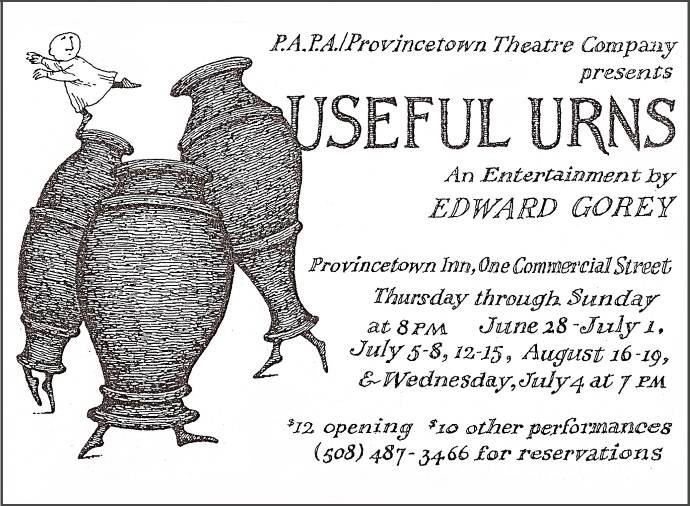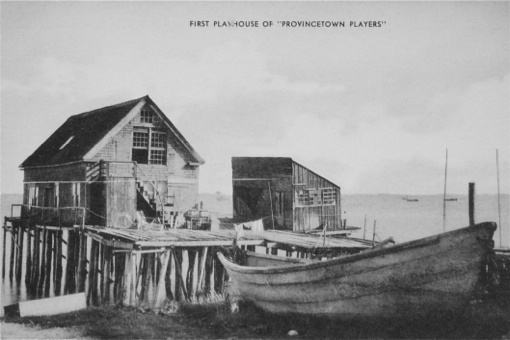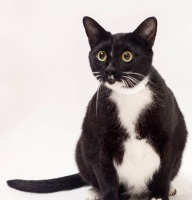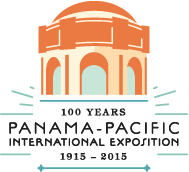Along with fishermen, this Cape-tip town is a magnet for theatre and other artists, from Susan Glaspell, Eugene O’Neill, and Tennessee Williams to Catharine Huntington, Ray Marten Wells, and Edward Gorey.
by CJ Verburg
 In the summer of 1990, the Provincetown Theatre Company presented the first of three annual “entertainments” written, directed, and designed by Cape Cod artist and author Edward Gorey. Useful Urns was performed by a cast of four women, four men, and assorted hand puppets in a former bowling alley by the sea. Our stage was a small wooden platform; our set was a stationary backboard and six portable giant urns painted on styrofoam slabs. Edward had pieced together a script from his short pieces, some published as books, some written for the stage. As the show’s instigator and producer, and the board president of PAPA [Provincetown Center for the Performing Arts]/PTC, I vowed always to work in theaters where, when things got tense, you could go outside and watch the ocean.
In the summer of 1990, the Provincetown Theatre Company presented the first of three annual “entertainments” written, directed, and designed by Cape Cod artist and author Edward Gorey. Useful Urns was performed by a cast of four women, four men, and assorted hand puppets in a former bowling alley by the sea. Our stage was a small wooden platform; our set was a stationary backboard and six portable giant urns painted on styrofoam slabs. Edward had pieced together a script from his short pieces, some published as books, some written for the stage. As the show’s instigator and producer, and the board president of PAPA [Provincetown Center for the Performing Arts]/PTC, I vowed always to work in theaters where, when things got tense, you could go outside and watch the ocean.
What had brought me and then Edward here from the mid-Cape was the Theatre Workshop. In 1987, artist Ray Marten Wells and aspiring playwright Michael Ferraro decided to boost the town’s tradition of home-grown theater with weekly gatherings of playwrights and directors. I joined at the very first meeting. The directors ran the first half, the writers the second half. Afterwards we’d walk “downtown” for drinks at the Governor Bradford, dinner at Gallerani’s or Napi’s, or beer and chili at Fat Jack’s.
 The story was that Ray Wells (who died in 2011 at the age of 103) stayed on when her friend Catharine Huntington and the rest of their Provincetown theater crowd left for Boston or New York. I suspect that what sparked Ray to start our workshop was Huntington’s death (1987, age 100). A longtime champion of Eugene O’Neill’s plays, she had owned and run the Provincetown Playhouse on the Wharf, which replaced the ramshackle home of the town’s previous theatre workshop.
The story was that Ray Wells (who died in 2011 at the age of 103) stayed on when her friend Catharine Huntington and the rest of their Provincetown theater crowd left for Boston or New York. I suspect that what sparked Ray to start our workshop was Huntington’s death (1987, age 100). A longtime champion of Eugene O’Neill’s plays, she had owned and run the Provincetown Playhouse on the Wharf, which replaced the ramshackle home of the town’s previous theatre workshop.

The legendary Provincetown Players “began when a group of writers and artists who were vacationing in Provincetown, MA presented their plays July 15, 1915 on the veranda of Hutchins Hapgood and Neith Boyce’s rented ocean-view cottage. . . . Back in Greenwich Village, New York City, where most of the group lived, [George Cram] Cook stirred up enthusiasm that fall and winter such that an even greater number of writers and artists made their way to Provincetown the next summer of 1916 [including] journalist and poet John Reed, writer Louise Bryant, painter Marsden Hartley, artists William and Marguerite Zorach, the famed “Hobo Poet” Harry Kemp, editor of The Masses Max Eastman, his wife Ida Rauh, Floyd Dell, and Eugene O’Neill.” The first plays O’Neill proposed were rejected, but when they read Bound East for Cardiff, a play set at sea, playwright Susan Glaspell wrote that the group ‘knew what they were for’.”
This being the 100th anniversary of the Players’ seminal summer, the Provincetown Theater is celebrating. Starting on July 2, the present-day company will reprise some of those early plays by Susan Glaspell, Eugene O’Neill, George Cram Cook, and Neith Boyce. Actor and arts commentator Stuard M. Derrick–another immigrant to Provincetown from New York–notes: “The Eugene O’Neill Society and the Susan Glaspell Society are coming . . . and there are panel discussions, galas, and lectures scheduled . . . already gearing up for the big O’Neill centenary next year.”
 Stuard adds: “Provincetown has really stepped up its game to attract some major celebrities,” including the Broadway @ Town Hall series, hosted by SiriusXM radio’s Seth Rudetsky and featuring stars including Matthew Broderick and Sarah Jessica Parker. “There is also a major Motherwell centennial going on right now . . . But to my mind, and in the opinion of many others who have seen it, undoubtedly one of the best shows of the summer has already opened: the phenomenal Jay Critchley retrospective at the Art Association — it’s just incredible in its scope and brilliantly curated and installed.”
Stuard adds: “Provincetown has really stepped up its game to attract some major celebrities,” including the Broadway @ Town Hall series, hosted by SiriusXM radio’s Seth Rudetsky and featuring stars including Matthew Broderick and Sarah Jessica Parker. “There is also a major Motherwell centennial going on right now . . . But to my mind, and in the opinion of many others who have seen it, undoubtedly one of the best shows of the summer has already opened: the phenomenal Jay Critchley retrospective at the Art Association — it’s just incredible in its scope and brilliantly curated and installed.”
So if you’re going to Cape Cod, be sure to see “From Aesop to Updike,” the 2015 book-cover art show at the Edward Gorey House, and allow plenty of time for the artistic feast in Provincetown.
 If you want to know more about Edward Gorey’s theatrical contributions, click CJ Verburg’s Books & Bio above for Edward Gorey On Stage: Playwright, Director, Designer, Performer: a Multimedia Memoir (full-color print and e-book).
If you want to know more about Edward Gorey’s theatrical contributions, click CJ Verburg’s Books & Bio above for Edward Gorey On Stage: Playwright, Director, Designer, Performer: a Multimedia Memoir (full-color print and e-book).














